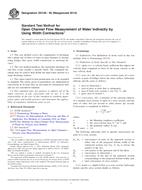We need your consent to use the individual data so that you can see information about your interests, among other things. Click "OK" to give your consent.
ASTM D5129-95(2014)
Standard Test Method for Open Channel Flow Measurement of Water Indirectly by Using Width Contractions
STANDARD published on 1.1.2014
The information about the standard:
Designation standards: ASTM D5129-95(2014)
Note: WITHDRAWN
Publication date standards: 1.1.2014
SKU: NS-29943
The number of pages: 37
Approximate weight : 111 g (0.24 lbs)
Country: American technical standard
Category: Technical standards ASTM
Annotation of standard text ASTM D5129-95(2014) :
Keywords:
flood, open channel flow, water discharge, ICS Number Code 17.120.20 (Flow in open channels)
Additional information
| Significance and Use | ||||||||
|
5.1 This test method is particularly useful to determine the discharge when it cannot be measured directly by some type of current meter to obtain velocities and with sounding weights to determine the cross section. 5.2 Even under the best conditions, the personnel available cannot cover all points of interest during a major flood. The engineer or technician cannot always obtain reliable results by direct methods if the stage is rising or falling very rapidly, if flowing ice or debris interferes with depth or velocity measurements, or if the cross section of an alluvial channel is scouring or filling significantly. 5.3 Under the worst conditions, access roads are blocked, cableways and bridges may be washed out, and knowledge of the flood frequently comes too late. Therefore, some type of indirect measurement is necessary. The contracted-opening method is commonly used on valley-floor streams. |
||||||||
| 1. Scope | ||||||||
|
1.1 This test method covers the computation of discharge (the volume rate of flow) of water in open channels or streams using bridges that cause width contractions as metering devices.1.2 This test method produces the maximum discharge for one flow event, usually a specific flood. The computed discharge may be used to help define the high-water portion of a stage-discharge relation. 1.3 The values stated in inch-pound units are to be regarded as standard. The values given in parentheses are mathematical conversions to SI units that are provided for information only and are not considered standard. 1.4 This standard does not purport to address all of the safety concerns, if any, associated with its use. It is the responsibility of the user of this standard to establish appropriate safety and health practices and determine the applicability of regulatory limitations prior to use. |
||||||||
| 2. Referenced Documents | ||||||||
|
We recommend:
Technical standards updating
Do you want to make sure you use only the valid technical standards?
We can offer you a solution which will provide you a monthly overview concerning the updating of standards which you use.
Would you like to know more? Look at this page.




 Cookies
Cookies
